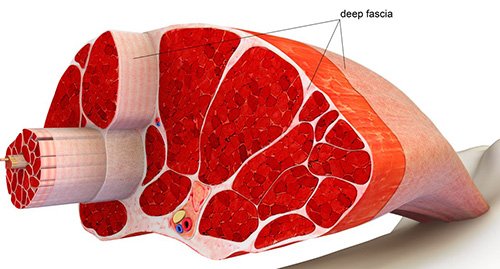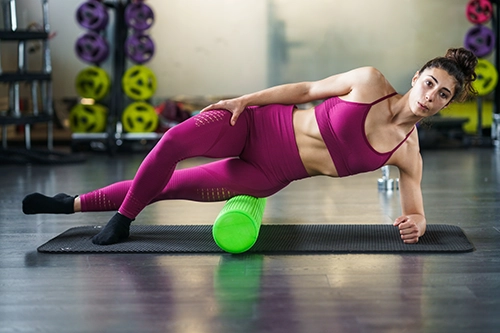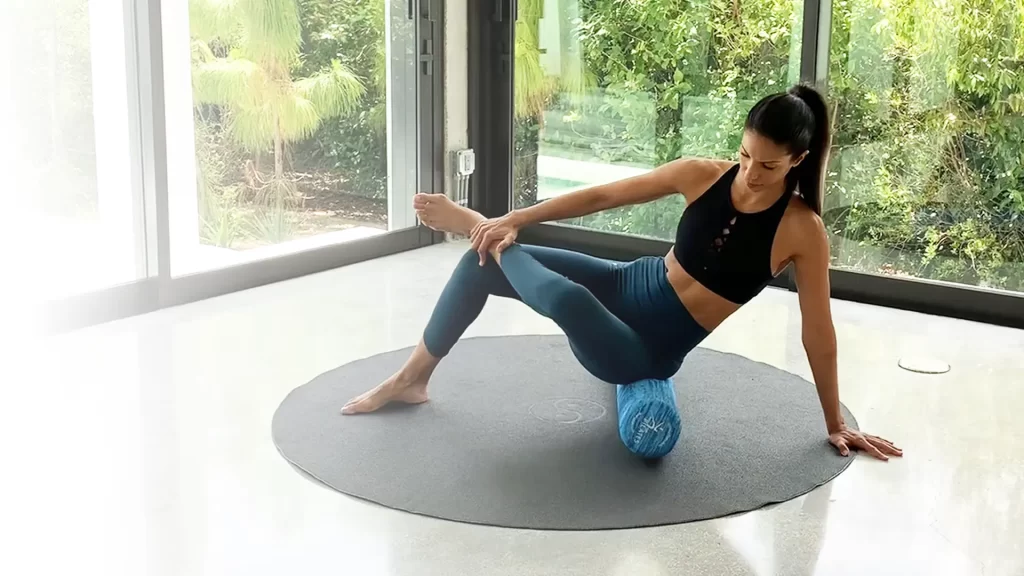You might be familiar with terms like “fascia” or “myofascial release,” or you’ve experienced rolling on a foam roller. Whether you’re new to the concept or you’ve integrated Self Myofascial Release (SMR) into your workout routine, this blog post is designed to clear up any confusion. I’ve done my best to keep it brief yet informative. 😉
We’ll begin by defining fascia and self-myofascial release (SMR), explore SMR’s true benefits, and explain how to do it correctly.
What is Fascia?
Fascia is a thin, tough, elastic type of connective tissue that wraps most structures within the human body, including muscles. It’s the biological that holds us together. It attaches, stabilizes, encloses, and separates muscles and other internal organs.
Fascia, like ligaments and tendons, primarily comprises collagen. However, they serve different roles: ligaments connect bones, tendons attach muscles to bones, and fascia envelop muscles, organs, and other structures.

The fascia is present throughout the entire body, not just the muscles. It’s classified by layer as superficial fascia, deep fascia and visceral fascia:
- Superficial fascia, which lies directly below the skin and usually contain collection of fat.
- Deep fascia, lies directly beneath the superficial fascia and is tougher, tighter and more compact than the superficial.
- Visceral (or Subserous) fascia, which covers and support the deep body cavities, e.g. the abdominal cavity and organs.
Myofascial Release relates to the deep fascia.
The deep fascia plays three key roles:
- It keeps muscle fibers, blood vessels, and nerves in alignment, essentially wrapping them in a supportive, movable layer.
- It helps transmit muscle force efficiently and with minimal friction.
- It provides a slick surface that lets muscles slide smoothly over each other, adapting as they contract and stretch.
Fascia is crucial for our body’s support and function, connecting all structures. In a healthy state, fascia is relaxed and wavy, allowing free movement and stretch.
Tight, restricted, and painful soft tissues can result from poor posture, chronic or acute injuries, surgery, muscle imbalances, stress, dehydration, and malnutrition.
These issues can reduce blood flow, increase pain, and limit motion, affecting fitness and daily activities. Fascial restrictions may also lead to decreased flexibility, stability, muscle cramps, fatigue, injuries, and postural issues.
What is Myofascial Release?
Myofascial release (MFR) targets the fascial and neural systems with stretching techniques. It serves as an alternative therapy, alleviating muscle stiffness and pain by relaxing muscles and enhancing blood and lymph circulation.
Chiropractors, physical therapists, and massage therapists are among the professionals offering MFR, each using distinct methods. Ideally, we’d have personal massage therapists for our muscle and fascia woes. Fortunately, self-myofascial release (SMR) is an accessible DIY option.
What is Self-Myofascial Release (SMR)?
Self-myofascial release, widely adopted in the fitness world, offers a more hands-on approach to fascial release techniques, putting you directly in control. By leveraging your own body weight and tools such as foam rollers, balls, or sticks, you’re able to perform self-massages. This method helps release tight muscle and fascia spots, boosts circulation and recovery, improves flexibility, and reduces muscle soreness.
How does it work?
By applying moderate pressure to areas of adhesion, often referred to as “knots” or tight spots, we can realign elastic muscle fibers from their tangled state into a more orderly arrangement that follows the direction of the muscle or fascia. Essentially, this gentle pressure acts much like a massage, breaking up the knots in the muscle and easing unwanted tension. Stretching alone may not suffice to alleviate muscle tightness.
The benefits of Self Myofascial Release:
- Release trigger points/”knots”, thus establish proper movement patterns and pain-free.
- Increases blood flow, which helps for faster recovery from workouts.
- Improve joint range of motion and flexibility.
- Maintains healthy functional muscular length.
- Relieves muscle soreness and joint stress.
- Corrects muscle imbalances.
- Improves neuromuscular efficiency.

When should you do a self-myofascial release (SMR)?
Consider integrating Self-Myofascial Release (SMR) into your regular workout routine…
- Before your workout to reduce tension in tight areas, enhancing mobility and function for improved performance.
- Post-workout, SMR helps relieve accumulated tension, minimizes soreness, and lowers the risk of injuries.
- It’s recommended to perform myofascial release before stretching exercises. Breaking up fascial adhesions, or knots, can enhance the muscle’s capacity to elongate during stretching.
- Alternatively, use SMR whenever you experience significant muscle tension.
How to Perform a Self-Myofascial Release?
Place the target muscle atop the roller and gently roll to locate any tight spots. When you find a tender area, pause for 30 to 90 seconds, relaxing more with each breath, then shift to the next sore area. Remember, focus on muscles, not bones or joints.
Example for Quadriceps: Start in a forearm plank, positioning the roller under your thighs, keeping your body straight. Roll from hips to knees, avoiding the knee joints. Use your shoulders and core for movement, experimenting with angles and pressure. To target different parts of your quadriceps, rotate your hips to roll the inner and outer thighs. For a deeper release, alternately bend your knees while rolling, adjusting your hips to access the full muscle. You can also try with both knees bent for an intensified effect.

How does it feel?
For some, rolling on a foam roller feels like a pleasant massage. However, it often resembles a deep tissue massage, becoming uncomfortable and painful. When performing a self-myofascial release, try to find the right amount of pressure that feels best to you. It also depends on the type of foam roller you’re using, and the level of its stiffness. You may want to start with a soft foam roller and then progress to a stiffer one.

Tools used for self-myofascial release:
Foam Roller (varying densities/stiffness and forms)
Massage balls or tennis ball (particular for smaller surface areas)
Roller Stick
Contraindications:
MFR and SMR might not be suitable for everyone. Some contraindications for these techniques include, but are not limited to:
- Recently injured areas
- People with malignancy (cancer or tumors conditions)
- Acute rheumatoid arthritis
- Advanced diabetes
- Severe Osteoporosis or advanced degenerative changes
- Circulatory problems
Your physician and physical therapist can help assess if MFR/SMR is the right treatment approach for you.



